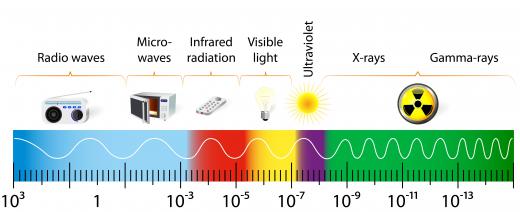What is Electromagnetic Light?
 Jessica Ellis
Jessica Ellis
Electromagnetic light is the another term for the products of electromagnetic activity. Due to the interaction of magnetic and electric fields, electromagnetic waves travel outward from their source at a variety of different frequencies and wavelengths. At the long wavelength end of the section, waves can be used for radio and TV, while at the short wavelength end powerful X-rays and gamma rays are created. Roughly in the middle of the electromagnetic spectrum is an area of waves visible to the human eye, known as visible light. While some forms of electromagnetic light are visible and some are not, they are all different forms of light wave.
Magnetic fields and electric fields tend to react off one another, causing a push and pull dynamic that is the origin of a light wave or electromagnetic light. Unlike other waves, light waves can travel through a vacuum. Light waves are measured by two primary criteria: the wavelength, which is determined by measuring the distance between two identical points in two successive waves, and the frequency, which is how many waves occur in a given time interval. Electromagnetic light with longer waves will have lower frequency, while electromagnetic light with short waves will have higher frequency.

At both extreme ends of the spectrum is a form of electromagnetic light that human eyes cannot process. These types of light waves include radio waves, infrared light, ultra violet light, X-rays, and gamma rays. Humans have developed many forms of imaging machines that can in fact translate these forms of light into a visible representation. Most human data about outer space comes from measuring and computing electromagnetic light that humans cannot actually see.

The colors of the visible spectrum, also called the rainbow, are defined by their wavelength and frequency, just like any other electromagnetic waves. Red is features the longest wavelength of any electromagnetic light, while violet features the shortest. If looking at a rainbow in the sky, colors always appear in a specific order, although some may be more obvious than others. Moving from top to bottom, every rainbow is red, orange, yellow, green, blue, indigo, and violet. This order corresponds to an increase of wavelength but a decrease in frequency.
Humans on Earth have the great fortune to have an enormous light source nearby: the Sun. Additionally, due to human innovation, there are also manufactured sources of light such as light bulbs. What a human perceives as a color is actually a light wave from a natural or manufactured source reflected off an object. Due to composition, an object perceived as blue will reflect blue but absorb all light waves except blue, while a yellow object will reflect yellow light but absorb any other visible wavelengths.
AS FEATURED ON:
AS FEATURED ON:












Discuss this Article
Post your comments